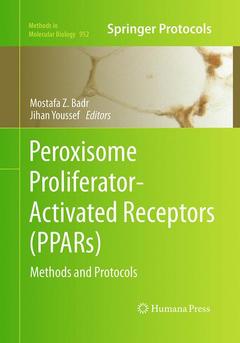Description
Peroxisome Proliferator-Activated Receptors (PPARs), 2013
Methods and Protocols
Methods in Molecular Biology Series, Vol. 952
Coordinators: Badr Mostafa Z., Youssef Jihan A.
Language: English
Subject for Peroxisome Proliferator-Activated Receptors (PPARs):
Publication date: 08-2016
Support: Print on demand
Publication date: 10-2012
343 p. · 17.8x25.4 cm · Hardback
Description
/li>Contents
/li>Comment
/li>
All three peroxisome proliferator-activated receptor (PPAR) subtypes share a high degree of structural homology but differ in function, tissue distribution and ligand specificity. PPARs play critical roles as regulators of numerous physiological as well as pathophysiological pathways, and efforts are currently underway to fully characterize their functioning and to develop safer and more effective PPAR modulators to treat a myriad of diseases and conditions. In Peroxisome proliferator-Activated Receptors: Methods and Protocols, renowned experts in the PPAR arena provide detailed protocols for investigating these receptors. Chapters contain methods ranging from the cloning of receptors to their knockdown, to protocols exploring posttranslational modifications of PPARs and coactivators, as well as receptor subcellular localization. Also assembled are methods to evaluate the involvement of these receptors in behavior functions, an emerging facet in PPAR research. Written in the successful Methods in Molecular Biology? series format, chapters include introductions to their respective topics, lists of the necessary materials and reagents, step-by-step, readily reproducible protocols, and notes on troubleshooting and avoiding known pitfalls.
With its well-honed methodologies, Peroxisome proliferator-Activated Receptors: Methods and Protocols, will be a useful resource for all seeking to advance their knowledge of this field.
PPARs: History and Advances.- PPAR-Alpha Cloning, Expression and Characterization.- PPARGC1A and PPARG Genotyping. Beginner’s Guide to Genotyping with Unlabeled Probes.- Generation of an Inducible, Cardiomyocyte-Specific Transgenic Mouse Model with PPARβ/d Overexpression.- Specific knockdown of PPARd Gene in Colon Cancer Cells by Lentivirus-Mediated RNA Interfering.- Dominant-Negative and Knockdown Approaches to Studying PPAR activity.- Producing PPARgamma2 Knockdown in Mouse Liver.- Adipose Tissue-Specific PPARg Gene Targeting.- Site-Directed Mutagenesis to Study the Role of Specific Amino Acids in the Ligand Binding Domain of PPARs.- PPAR SUMOylation: Some Useful Experimental Tips.- Analyzing Phosphorylation-Dependent Regulation of Subcellular Transcriptional Activity of Transcriptional Coactivator NT-PGC-1a.- In vivo Studies of PPAR-Chromatin Interactions: Chromatin Immunoprecipitation for Single-Locus and Genomewide Analyses.- FISH Analysis Using PPARg Specific Probes for Detection of PAX8-PPARg Translocation in Follicular Thyroid Neoplasms.- Immunohistochemical Techniques to Identify and Localize Proteins of Interest in Paraffin-Embedded Tissue Sections.- Determination of PPAR Expression by Western-Blot.- Fluorescence Resonance Energy Transfer Techniques to Study Ligand-Mediated Interactions of PPARs with Coregulators.- Estimation of the PPARa Agonism of Fibrates by a Combined MM-Docking Approach.- Combined Biophysical and Cell-based Approaches for the Assessment of Ligand Binding to PPARg.- Exploring PPAR Modulation in Experimental Mice.- Induction of Adipogenic Differentiation in Three-Dimensional Culture Model on a Novel Microfabricated Scaffold.- Analyzing PPAa/Ligand Interactions by Chemical Cross-Linking and High-Resolution Mass Spectrometry.- Synthesis, Mass Spectrometric Characterization, and Analysis of the PPARd Agonist GW1516 and its Major Human Metabolites – Targets in Sports Drug Testing.- LC-MS-Based Method for the Qualitativeand Quantitative Analysis of the Novel PPARg Agonist KR-62980.- Behavioral Paradigms to Evaluate PPAR Modulation in Animal Models of Brain Injury.




